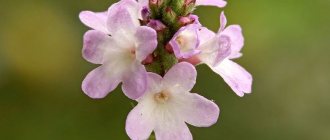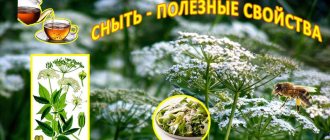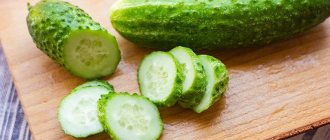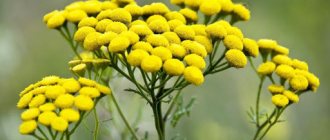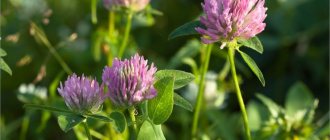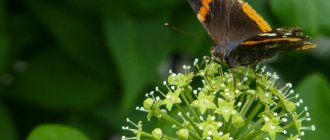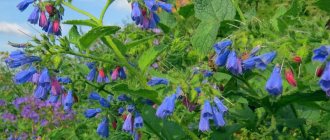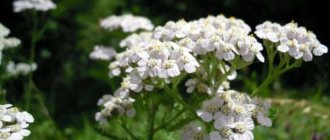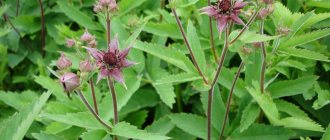From people who are alarmed or frightened by something, you can often hear the wish to “drink valerian.” Preparations from valerian officinalis were known back in Ancient Greece, where it was believed that they were able to “control thoughts.” This article will tell you about the medicinal properties of the plant, its health benefits and harms, and answer questions about whether it is possible to use magic drops during pregnancy and menopause, give them to cats and grow medicinal herbs in the garden.
Valerian inflorescences – corymbs or panicles
Description of the plant
The Valerian genus belongs to the Honeysuckle family and includes over 280 species, but only Valerian officinalis is used in medicine. This is a herbaceous perennial with an average height of 1.2 m, externally similar to marigold, dill, angelica and other umbelliferae, from which it differs in flowers. In Umbelliferae, the petals of the corolla are short and free, which is why the entire flower looks like a tiny wheel. And in valerian, the petals stretch out and grow together, turning into something like a long bell.
in valerian, the petals stretch out and grow together, turning into something like a long bell.
The stems of the plant are erect, with a cavity inside and grooves outside. The leaves are pinnately dissected, and the higher the leaf is located, the shorter its petiole. Inflorescences are corymbs or panicles. The medicinal raw materials are rhizomes with valerian roots, which have a strong specific odor.
The plant's Latin name comes from the word valere, which means "to be healthy." People call it “aromatnik” and “earth incense”. The increased interest in this cat herb is reflected in the names “miaun”, “cat root”, “cat grass”.
Valerian officinalis belongs to the valerian family (Valerianaceae). This is one of the plants used by humans since ancient times; doctors of Ancient Greece, Rome, Egypt, India, and the East were aware of its healing properties.
In total, there are over 200 species of this genus in the world, about 40 of them are found in Russia and the CIS. The generic name Valerian officinalis comes from the Latin verb “valere,” which means “to be healthy.” According to another version, the genus name is of French origin and is associated with the local name Valeria in Panonia (a region in France), where this plant originates; It is also believed that the plant was named after the Roman emperor Valerian or the Roman physician Pliny Valerian. But be that as it may, valerian is an ancient medicinal plant.
Valerian officinalis is popularly called “cat root”, “shag grass”, “fever root”, “forest incense”, “incense”, “pharmaceutical maun”, “fragrance”, “sore plant”, etc. A distinctive feature of valerian is - characteristic smell. The root and rhizome have a strong, distinctive odor. In ancient times it was called “nardos”, or “sumbul”, which means “fragrant”. Under such names it was mentioned in Egyptian papyri, the Bible, and treatises of ancient Greek, Roman and Indian healers. Dioscorides pointed to the ability of the roots of this plant to “control thoughts.” Pliny also classified valerian as a means of stimulating brain activity. The Arabs widely used valerian. An outstanding representative of Arab medicine, thinker and physician Abu Ali ibn Sina, better known in Europe as Avicenna, described Nardos in detail in his brilliant work “The Canon of Medical Science” and used it as a means to strengthen the brain.
Valerian officinalis is distributed throughout almost the entire territory of the country, with the exception of the Far North, Siberia and the desert regions of Central Asia. Valerian is a perennial herbaceous plant up to 2 meters high. Blooms in May–August. The flowers are small, fragrant, white or pink, collected in paniculate inflorescences. The fruits ripen in June–September. Widely cultivated as a valuable medicinal plant.
The medicinal raw material is the rhizome with roots. They contain essential oil, bornyl isovalerate, isovaleric, valeric acids and borneol, mertinol, tannins, sugars, formic, malic, acetic, stearic and palmitic acids, flavonoid compounds. Medicinal raw materials are harvested in autumn or early spring and dried in dryers at a temperature not exceeding 35 °C.
Valerian has been very popular at all times as a medicine that has the ability to calm the excited nervous system, dilate the blood vessels of the heart, normalize sleep, and enhance the effect of sleeping pills.
In medical practice, valerian is used as a medicine that has a sedative, antispasmodic (in relation to the smooth muscles of the gastrointestinal tract) and choleretic effects. It is used for chronic functional disorders of the central nervous system, hysteria, convulsions, coronary circulatory disorders, for the treatment and prevention of angina pectoris, heart defects (often with other sedatives and cardiac drugs), diseases of the gastrointestinal tract associated with impaired secretory function, and disorders of the endocrine glands, with hyperfunction of the thyroid gland, menopausal disorders, vitamin deficiencies. It has a positive effect on sexual activity; used externally in the treatment of lichen planus, neurodermatitis, in cosmetics, to reduce sweating.
Valerian tincture is included in the camphor-valerian, lily of the valley-valerian, Zelenin, Votchal drops. The complex preparations: valocordin, valocormid, valosedan, cardiovalen include valerian essential oil. The following dosage forms are known from the raw materials of valerian officinalis: plant raw materials crushed in packs and filter bags for the preparation of infusions and decoctions, valerian extract in coated tablets and capsules.
Valerian infusion is prescribed 30 minutes after meals: adults, 1 tablespoon 3-4 times a day; children over 12 years old - 1 tablespoon 2-3 times a day; children from 7 to 12 years old - 1 dessert spoon 2-3 times a day; children from 3 to 6 years old - 1 teaspoon 2-3 times a day; from 1 year to 3 years – 1/2 teaspoon 2 times a day. It is recommended to shake the infusion before use. To prepare the decoction, take 2 teaspoons of crushed valerian root and pour a glass of cold water, boil for 5 minutes, filter.
Valerian tincture is prepared with 70% alcohol (in a ratio of 1:5). Adults are prescribed 20-30 drops per dose 3-4 times a day, children - as many drops as the child is old. Available in 30 ml bottles.
Thick valerian extract is used in the form of film-coated tablets or capsules. Each tablet contains 0.02 g of thick valerian extract. Orally 2 tablets or 1 capsule 2-3 times a day; for insomnia - an hour before bedtime. For older children – 1 tablet 1–3 times a day. Tablets or capsules are convenient to take, but a freshly prepared infusion of valerian has a more pronounced effect.
Camphor-valerian drops are used as a sedative, mainly for cardiovascular neuroses. Prescribe 15–20 drops 3 times a day.
Lily of the valley-valerian drops are used for cardiac neuroses, as well as for cardiac disorders without compromising the compensation of the cardiovascular system.
Complex drugs - Valocordin, Valokormid, Valosedan, Cardiovalen have sedative, cardiotonic and antispasmodic effects.
The healing properties of valerian in aromatherapy are known. The smells of plants not only help treat diseases. They can be used by healthy people in a wide variety of life situations, actually managing their well-being. Thus, the smells of valerian, mint, and geranium can be useful for nervous stress, anxiety before important performances, exams, as aids after hard physical work, during active recreation, and during calming autogenic training.
In the USA, valerian is used in the production of essences, liqueurs, and tinctures. As a flavoring agent, it is included in the preparation for Havana cigars and Turkish tobacco.
Valerian is used as a spice mainly in European countries. In Britain, fresh leaves are added to salads. Sometimes they are used as a salad side dish for fish dishes.
In folk medicine, valerian has been used for insomnia since the reign of Alexander Nevsky, who often resorted to its help himself. The cultivation and collection of valerian on an industrial basis for hospitals began under Peter I. By his order, a plantation of medicinal plants was organized. In the 18th century Valerian is included in all European pharmacopoeias.
Valerian occupies a worthy place among magical plants. Since ancient times, magical properties have been attributed to valerian in Rus', which is to a certain extent due to its use by the Scythians. The following legend tells about this very convincingly. Once Saint Panteleimon the healer went into the forest with his bag to collect medicinal herbs. The night turned out to be very dark, not a single star was shining. He went out to the forest edge and suddenly among the bushes he saw many light pink flickering lights coming out of the ground in “thin” streams. These streams, rising above the ground, formed clouds in the shape of a pink flower. Since the lights were coming from the ground, Panteleimon began to dig up the roots of the strange plant and, to his surprise, discovered that the more he dug them, the better he felt. When he collected the full amount of these magic roots, his soul was filled with joy and fun. Walking through the villages, Panteleimon gave these roots to sick people and said: “Be healthy.” From those roots, people gained peace of mind, vigor and a surge of vitality.
Information about the authors: Samylina Irina Aleksandrovna – Doctor of Pharmaceutical Sciences, Professor, Corresponding Member of the Russian Academy of Medical Sciences, Director of the Research Institute of Pharmacy; Head of the Department of Pharmacognosy MMA named after. THEM. Sechenov. Tel.; Sorokina Alla Anatolyevna – Doctor of Pharmaceutical Sciences, Professor of the Department of Pharmacognosy of the MMA named after. THEM. Sechenov. Tel.; Pyatigorskaya Natalya Valerievna – candidate of pharmaceutical sciences, associate professor, deputy director of the Research Institute of Pharmacy for scientific work.
Tel.
Distribution and habitats
The Mediterranean region is considered to be the center of origin of valerian: Italy, the Balkans, Egypt. From there the plant spread throughout Europe and northern Asia. In Russia, cat grass is found everywhere, with the exception of extremely cold areas with short summers: the Yamalo-Nenets Autonomous Okrug, Chukotka and Kamchatka. The further south the thickets are located, the larger the rhizomes are formed.
Medieval healers revered valerian as a remedy that brought calm to the soul, harmony and peace to the family.
Valerian is a moisture-loving plant. It grows in low-lying meadows with high groundwater levels, peat bogs and grass swamps. Traditional healers look for healing raw materials along the shores of forest lakes and ponds, in damp forest edges and swampy clearings. Valerian root is so in demand in medicine that the plant has been introduced into cultivation and is widely cultivated. Even varieties have been bred (“Maun”, “Cardiola”) that provide raw materials of higher quality than wild grass.
Features of growing valerian
In order not to look for valerian in a pharmacy, and also to be sure that the plant is environmentally friendly, you can grow it in your own garden.
Valerian officinalis cultivation is as follows:
- The site for any type of valerian should be sunny and warm. The plant grows best in moist areas with partial shade. Red valerian is best planted in moderately dry soil, as it does not like stagnant water. This type of plant can grow even in very hot places.
- Valerian bravely survives the winter. Most plants can grow for a long time without replanting. Only red valerian needs to be planted from seed every three years. It can self-seed. In this case, you need to mulch or cover the ground before wintering.
- Valerian is easy to care for. It is enough to water it moderately and weed it in a timely manner.
- In order for valerian to bloom better, it needs to be fed. Typically, fertilizing is carried out using complex mineral fertilizers. You need to fertilize the soil once every 14 days.
- In autumn, the flowers are cut off at the root.
- Valerian propagates by seeds or by dividing the bush. Seeds are sown in the soil before winter or spring. If you plan to plant from seedlings, then the procedure is carried out in April or May. It is recommended to divide the bushes in the spring, before the leaves bloom on the plant.
If valerian is sown from seeds, it will grow small in size with small roots in the first year. To obtain a healing rhizome, you will need to grow valerian for three or more years. Seed sowing of a plant is painstaking. Since the grass is capricious and loses its viability easily. For this reason, valerian is sown immediately after collecting the seeds. It is important to pick seedlings when necessary.
Soil preparation
Before planting valerian in the soil, it is necessary to prepare the planting site. In the fall, dig up the soil and enrich it with compost or humus. It is also important to fertilize the soil with complex mineral fertilizers.
Chemical composition
Rhizomes with valerian roots accumulate up to 2% essential oil, which is easily extracted by steam distillation. The oil is rich in valerenic acid (the main active ingredient), as well as borneol, sesquiterpenes and other odorous substances, giving it a woody-balsamic aroma.
The high content of actinidin in the essential oil explains why valerian has such an unusual effect on cats. Feeling its smell, the animal begins to roll on the floor, purr loudly, and bite objects. The absence of such a reaction in kittens suggests that actinidin is similar in properties to cat urine pheromones and causes the pet to become sexually aroused.
Valerian is considered one of the most ancient medicinal plants
Pharmacological properties
According to pharmacognosy, valerian officinalis has a number of positive effects on the human body, due to which it is used for medical purposes. Pharmacological actions are as follows:
- Calming effect. Perhaps this is the most famous property of this plant. If you ask a person what he would drink “for his nerves,” he will almost certainly answer – drops of valerian. Indeed, the herb helps calm the central nervous system and relieve muscle spasms. This in turn allows you to cope with nervous disorders, sleep problems, high blood pressure, and heart attacks.
- Normalization of the digestive process. Valerian-based products help relax smooth muscles, relieve spasms, and improve peristalsis. Therefore, the plant helps well with problems with the gastrointestinal tract, for example, with frequent constipation and pain in the gall bladder.
- Improving a woman's condition during menstruation. Many girls do not tolerate menstruation well, they experience pressure surges, headaches, and increased irritability. Valerian helps to cope with these manifestations.
- Allergic reaction. The herb calms the nervous system in case of neurodermatitis, which helps reduce the amount of skin rashes and the intensity of itching.
Valerian has a multifaceted effect on the body
. Valerian is harmless and does not harm human health. But you still need to use it in the dosages recommended by the instructions, as side effects are possible.
Application
Valerian is considered one of the most ancient medicinal plants. It is included in the State Pharmacopoeia of the Russian Federation and is used by official medicine for:
- chronic central nervous system disorders, neuroses and hysteria;
- stomach pain and constipation of a neurotic nature;
- complex treatment of mental trauma;
- heart pain and menstrual pain;
- thyrotoxicosis;
- insomnia;
- hypertension;
- migraine.
Cat grass stabilizes the vasodilatory effects of other drugs used in the treatment of hypertension. It persistently lowers blood pressure, easing the condition of weather-dependent people. By enhancing the effect of antipsychotics, the plant allows you to reduce their dosage. It is also used in the treatment of obesity as an anorexigenic agent that suppresses the functioning of the hunger center.
In Umbelliferae, the petals of the corolla are short and free, which is why the whole flower looks like a tiny wheel.
Valerian is used very carefully during pregnancy. In the first trimester, its drugs are contraindicated, but for late toxicosis they are sometimes prescribed as a sedative. The plant is widely used during menopause to improve sleep quality and eliminate increased irritability that accompanies menopause.
Features of plant care
Valerian is easy to care for. Despite the fact that it can withstand drought, it is still worth watering. To form high-quality rhizomes, valerian needs to be watered abundantly, since moisture promotes the development of valuable medicinal rhizomes. During the summer it is important to feed valerian three times. You can simply water the plant with regular mineral fertilizers. Be sure to loosen the soil between the rows and remove weeds. If the flower stalks are removed in mid-summer, valerian will acquire powerful rhizomes. If you plant and care for valerian correctly for one season, you can get 300 grams of high-quality medicinal raw materials.
Medicinal properties and harm
The medicinal properties and contraindications of valerian root are associated with its high content of essential oil, which has a pronounced sedative effect. It also has other healing properties:
- reduces agitation caused by caffeine intake;
- enhances the separation of bile and gastric juice;
- reduces the sensitizing effect of drugs;
- reduces spasms of smooth muscles;
- enhances the effect of sleeping pills;
- improves coronary circulation.
An interesting property of the plant is its ability to relieve convulsions caused by poisoning with certain alkaloids, in particular strychnine and brucine. Pharmacists consider it promising for the development of new treatments for epilepsy.
The benefits and harms of cat grass are determined by the patient’s condition: in some cases, it can have the opposite effect: sleep disturbances, increased neuroses. An overdose of the drug leads to the same consequences.
Type of valerian in nature
Contraindications to the use of valerian are hypersensitivity, breastfeeding, and the need to drive a car. It is prescribed to pregnant women in extreme cases.
The use of valerian in childhood
To treat nervous disorders, epilepsy, and also eliminate fear in children, the doctor may prescribe valerian. Products containing the plant are considered potent, so they should be taken drop by drop for each child’s year. You can prepare valerian roots in the form of decoctions for bathing. After a healing bath, droplets of water should dry on the baby’s body on their own. After the procedure, place the child in bed to rest. It is recommended to take baths with valerian every other day for 5–7 minutes before bedtime.
Children can be given a water infusion of valerian for abdominal pain for better elimination of gas. According to the regimen prescribed by the doctor, children can be given medications with valerian for better appetite, digestion, better functioning of the liver and gall bladder. If you are afraid to give your baby an infusion of valerian orally when you have stomach pain, soak a piece of diaper in it and gently wipe the baby’s tummy clockwise. The pain will become less, and the baby will stop crying from discomfort in the tummy. If parasites are found in the baby’s body, as well as with dysentery, you can do enemas with chamomile and valerian. In this case, the doctor should advise you on the correct use of herbal raw materials.
Now you know how valerian is grown, what care the plant needs, as well as why and how it is used. It is important to plant and grow the plant correctly in order to collect high-quality raw materials for the preparation of healing folk remedies.
Collection, preparation and storage
Valerian root is harvested in early October, when it has accumulated maximum essential oil. The raw materials are dug up, freed from the ground, cleaned of remnants of shoots and washed. Farms use potato diggers or even special valerian harvesters for harvesting.
The prepared rhizomes are cut into pieces, dried, laid out on a tarpaulin and dried at a temperature not exceeding 40 degrees, turning over periodically.
Valerian root is so in demand in medicine that the plant has been introduced into cultivation and is widely cultivated
In nature, cat grass does not form large thickets suitable for mass harvesting, so it can be cultivated in the garden as a herbaceous plant for open ground. In this case, part of the plantings must be left to obtain seeds.
Store raw materials in paper bags in cool, dark places inaccessible to cats, who can steal them. The shelf life is no more than 3 years.
Traditional treatment recipes
For rhinitis: 1 tbsp. pour a spoonful of valerian roots with 100 grams of olive oil. Leave in a warm place for 10 days. Place 1-2 drops into the nose, 1-2 times a day. Long-term treatment
For menopause: 10 g. Pour 1 cup of boiling water over valerian roots, leave until cool, strain. Drink 1/2 glass at night or during the day
For obesity : pour 70 grams of crushed valerian roots into 1 liter of cool water, heat in a boiling water bath for 30 minutes, then remove from heat and leave for 10 minutes. Strain and add boiled water to the original volume. Drink 70 ml. 20 minutes before meals
For scarlet fever: Grind valerian rhizomes in a blender to a powder. Use 1-2 grams per dose and no more than 3-4 grams of powder throughout the day
For headaches: Pour 1 tbsp. spoon of crushed valerian root with a glass of boiling water, hold in a water bath for 15 minutes, cool, strain, add boiled water to the original volume. Take 1/4 cup three times a day after meals
To cleanse blood vessels: 100 gr. mix dill seeds with 50 gr. crushed valerian rhizomes, pour 2 liters. boiled water. Let the drink cool, add 2 tbsp. spoons of honey, close the lid tightly and leave for 24 hours in a warm place. Drink 1 tbsp. spoon 30 minutes before meals, 3 times a day. The course of treatment is 20 days, then a break of 10 days and take a second course
For myocardial infarction: pour 50 grams of root crushed in a blender into 200 ml. boiled water, leave in a thermos for 5 hours. Heat again in a boiling water bath for 30 minutes. Leave for 10 minutes. Strain and add boiled water to the original volume. Drink 1 teaspoon before bedtime
For heart failure: . 1 tbsp. pour 200 ml of chopped roots into a spoon. boiled water, leave in a thermos for 1 hour, strain, add honey to taste. Drink 70 ml. on an empty stomach and before bed
For neuroses, migraines, insomnia: 5 g. Brew crushed valerian root in 250 ml of boiling water, simmer in a thermos for at least 2 hours, strain. Take 0.5 cups morning and evening
For nervous shock (“fright”) in children: dilute 7-10 drops of juice in 1 teaspoon of boiled water. Take 5 times a day
If you need to quickly relieve nervous tension and resulting headaches, you can prepare tea from the root of valerian officinalis and lemon balm leaves, mixed in equal parts. To do this, pour 2 teaspoons of herbal mixture into 250 ml. boiling water, let it brew for 15 minutes, strain and drink in small sips
Sleeping tea is also prepared, but the same amount of hops is added to the valerian root instead of lemon balm. Drink it at night, before going to bed
Where does it grow
Valerian herb grows in Europe, Asia, South and North America. In Russia it grows everywhere, except in the Far North and desert zones. Loves swampy areas, wet forests and bushes, meadows, banks of rivers, lakes and streams.
Valerian officinalis medicinal properties
Preparation of medicinal raw materials
The harvesting of valerian roots and rhizomes should begin in the second year, when they accumulate the maximum amount of essential oil, valeric acid, tannins and other useful elements. It is best to do this in the fall after the end of the growing season. In two years, the rhizomes grow in weight up to 200-300g.
Freshly dug material is thoroughly washed under running water and dried in a good draft and sun for 2-3 days. After this, the roots are removed into the shade and dried there completely. During this time, they turn from light and without a characteristic odor to dark brown and acquire a familiar aroma. It is recommended to cut rhizomes that are too thick lengthwise to facilitate and speed up the process. The easiest way is to immediately cut them with garden shears for ease of further use.
Care must be taken to ensure that the roots are laid out to dry out of the reach of cats.
The slower the drying process, the stronger and more persistent the characteristic odor of medicinal raw materials will be.
Growing in the garden
Typically, this perennial is grown from seeds in a garden plot (or in mass cultivation conditions). They can be purchased at a specialized store, or collected yourself from plants that grow wild nearby.
Valerian officinalis
The most suitable time for planting valerian seeds is mid-July , but if this is not possible, then you can sow them in early spring.
In the dug up area, shallow grooves are made into which planting material is sown and covered with humus on top. After about 10 - 14 days, the first shoots will appear. When the seedlings have 4-5 permanent leaves, they can be transplanted to a previously prepared permanent place, where they will grow until it is time to collect medicinal raw materials.
The selected area should be sunny. Before transplanting valerian seedlings into it, the area is dug up and humus is added to it at the rate of 10 kg per 1 m2.
When planting seedlings in a permanent place, the distance between them should be at least 0.3 m, and the row spacing should be 0.1 m. The beds must be regularly loosened and weeded, watering must be regular, but not too wet.
Valerian in the garden
When digging up rhizomes, you should remember: one plant is being dug out from two neighboring ones. In autumn, ammophos should be applied under the remaining plants.
